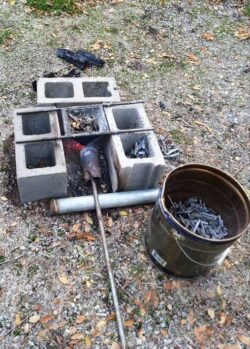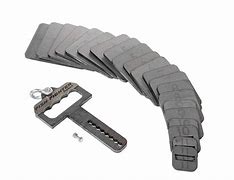Anchors are designed to stop and hold a boat. The type of anchor that you use is very important. Not all anchors are best for all situations. It is also important to stop your boat and not drag the anchor along the bottom. This drag will destroy insect habitat and can result in a jerking stop that can cause damage or injury to the crew.
My first anchor for a canoe was a sack full of rocks. The advantage was that most watersheds had plenty of rocks on site, so I did not have to carry extra weight. The netted sack could be made into any weight, easily handled and if lost, oh well. A nylon rope would hold the bag and the rocks formed to fit the bottom.
East coast anchors for the marine, sandy environs required a shovel style blade that would dig into the sandy bottom. When drifting or floating in a river, this is not what you want. This style anchor will surely stop the boat but forget about getting it back off the bottom. It will dig in and get stuck faster than you can say “anchors aweigh”!
Drift Boats are designed to drift. You can certainly use bay and lake anchors in a lake or bay but not on a flowing river. You need an anchor with a different design that will slow and stop the drift but not get stuck.
Pyramid style anchors are commonly used for most western drift boat applications. These lead anchors weigh 15-25 lbs. and work well. Round, lead, cannonball style anchors also work well but tend to be lighter than what is needed.
You can make your own anchor using a forge made from cinder blocks. Make a pyramid shaped form out of other metal. You can also use the forge to just melt the lead and form the anchor in a wooden form. The wood will burn but hold together long enough to form the anchor. Place the hook or large eyebolt inside as you pour in the hot lead. The anchor does not have to be pretty. It just needs to work. 
The BEST anchor that I have used weighs in at 45 lbs. It was built from a cylinder of steel with short metal posts welded to it. When dropped, the boat would stop, and the 2-inch offset welded posts allowed me to retrieve the anchor easily. This is a heavy anchor but when needing to stop a drift boat of several hundred pounds with a trio of beefy fishermen, cooler and gear, 45 pounds does not seem like much.
A big part of a drift boat anchor is the anchor release and retrieval system. Side mounted anchor brackets help but the floor pedal system works the best. This pedal release allows the oarsman to release the anchor while keeping both hands on the oars. He can also stop the release at a point appropriate for depth and current.
Use a flexible or moveable connection to the anchor hook. A large clocking chain link style connection can be tightened and removed. Make sur that you also have a suitable rope that is thick and strong. A thicker rope is easier to grab and pull. The sun has a way of degrading rope, so keep your rope fresh and store out of the sun.
Different weight anchors are ideal in different water conditions. High and fast-moving water requires more weight to stop, especially with a boat full pf big fishermen and gear. In the Summer low water conditions, 25 lb. anchors will do the job. You can buy or make variable weight anchors that stack plates on a key. You still maintain the pyramid shape but can adjust the weights. 
Anchors can be noisy. Anchors with moving parts or removeable plates loosen and make noise. This does not help the fishing. Consider covering the anchor with a rubber bedliner product or coating. A bright color may be helpful if you ever need to find a lost anchor.
Traveling down the road with a connected anchor is not a good idea. Take the anchor off and store it where it will not bounce around. 40 or more pounds of spiked metal can do some big damage to fiberglass, metal, and wood. Now I know that some boats have cradles and brackets to carry them, but every guy I know with this carry bracket has lost an anchor or had it swinging around causing damage. Usually, they add a bungy or strap but sometimes they forget and… One of my friends used an old cooler that fit the anchor. He attached it to floor of his boat trailer, near the hitch end. Doing the same idea with a custom box would also help.
Never tie a knot at the end of your anchor rope. This will prevent you from dropping the anchor in an emergency. You can always come back for the anchor. Losing an anchor is a better choice than losing a boat or life.
STOP when you need to!
Montana Grant